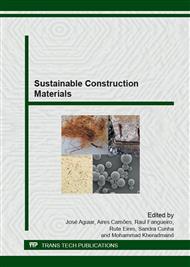p.33
p.46
p.54
p.62
p.72
p.85
p.97
p.113
p.121
Parabolic Solar Collector Coverage Made of High-Performance Concrete with Addition of Active Rice Husk Silica Integrated to a Biomass Thermoelectric Unit
Abstract:
Production of active rice husk silica (ARHS) in bubbling fluidized bed boiler of a thermoelectric unit (TEU) and its addition to high performance concrete (HPC) with a compression resistance of 90 MPa was developed in the last 10 years. A first factory in Brazil was established at Alegrete town, RS, and other factories are under planning. Data of ARHS production, specification and HPC trace are presented. Design of parabolic solar collector coverage (PSCC) for air heating for biomass drying in a special silo of the TEU is presented as well. Cost of HPC/ARHS is 10 times less than steel (USD 200/ton vs. USD 2000/ton, specific mass 2.5 vs. 7.6 g/cm3, respectively). Those characteristics allow simultaneous solution of four ecological problems: large span coverage, rain water collection, daily solar energy collection and storage, and drying of biomass. The integration of those characteristics results in decrease of biomass consumption maintaining the same UTE efficiency. Tracking parabolic solar collector can be avoided between Cancer and Capricorn Tropics, and it is sufficient its eastern-western orientation with inclination to the Equator by the latitude angle. Coverage of the area occupied by TEU is sufficient to dry its biomass consumption. Preheating of boiler water with solar energy is possible decreasing biomass consumption in sunny days; biomass is partially consummed at night and cloudy days. Coupling the above technologies with high pressure steam TEU and fast-growing short-rotation forest gives to the biomass electrical energy generation a competitive economical position with hydraulic, coal, natural gas, and aeolic energy generation.
Info:
Periodical:
Pages:
72-82
Citation:
Online since:
December 2014
Price:
Сopyright:
© 2015 Trans Tech Publications Ltd. All Rights Reserved
Share:
Citation:


